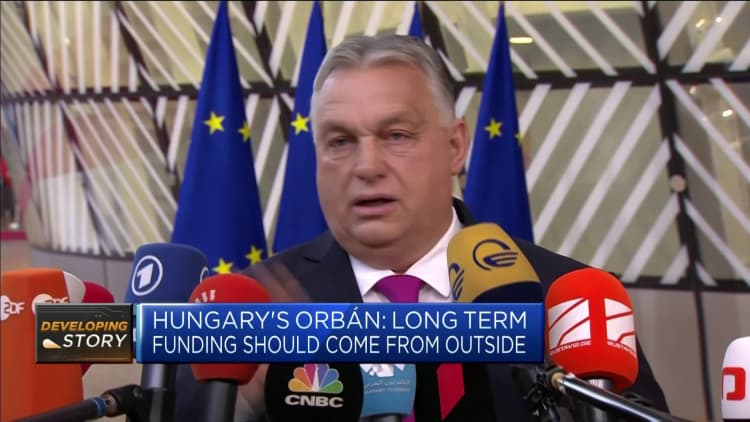
BRUSSELS — European heads of state are gearing up for a difficult two-day gathering where support for Ukraine is at the top of the agenda, but internal divisions threaten any significant action toward Kyiv.
The meeting comes at a crunch time for Ukraine, as President Volodymyr Zelenskyy hops across the world seeking further aid in the fight against Russia’s invasion. He started the week in Argentina, then travelled to the United States and landed in Norway on Wednesday.
Throughout all of his stops, he delivered one message: cutting support to Ukraine is a gift to Russia’s president, Vladimir Putin.

EU leaders arrive in Brussels for European Council meeting
“We must make decisions,” European Council President Charles Michel, who will be chairing the summit, told CNBC on Tuesday.
“It is our duty to make sure we protect the interest of the European Union by supporting Ukraine.”
What’s at stake
Some 50 billion euros ($54.43 billion) are on the table. The European Commission, the executive arm of the EU, proposed in June to send this sum to Ukraine between 2024 and 2027, but opposition from Hungary, whose prime minister met with Putin in person in October, is blocking the disbursement.
EU leaders will also discuss whether to start official negotiations with Ukraine for the nation’s potential future accession to the bloc. Hungary has, once again, expressed reservations. A handful of other EU member states, such as Italy, have also raised issues over enlarging the EU.
Speaking to CNBC on Tuesday, Ukraine’s deputy prime minister, Olga Stefanishyna, said that the start of official negotiations would be a “major guarantee of Ukraine sustainability.”
“We need these messages to keep on being mobilized,” she added.
Ukraine deputy PM: Confident there are enough options to reach an EU aid deal
Nearly two years since Russia’s full-scale invasion of Ukraine, western support for Kyiv is flattening. There was a nearly 90% drop in newly committed aid to Ukraine between August and October, compared with the same period of 2022, data from the Kiel Institute showed last week.
“Ukraine now increasingly relies on a core group of donors such as the U.S., Germany, and the Nordic and Eastern European countries that continue to pledge and deliver both financial aid and important weaponry,” the institute said.
The recent war between Palestinian militant group Hamas and Israel has also drifted attention away from Kyiv, while inflationary pressures have limited the ability of Western governments to provide more aid. At the same time, Russia retains an advantage when it comes to military strength.
Russia’s sweet spot
“Russia will likely continue to have a considerable advantage in terms of the availability of military equipment, munitions, and manpower, at least in the first half of 2024,” Andrius Tursa, Central and Eastern Europe Advisor at consultancy firm Teneo, said.
Read more CNBC politics coverage
- Two-month battle to replace ex-Rep. George Santos could cost $20 million
- Supreme Court rejects appeal bid by Trump clemency recipient Philip Esformes
“Having mobilized its economy for the war, Russia is rapidly increasing its military output, in addition to supplies from North Korea and Iran. Moscow is also keeping up military recruitment to compensate for vast manpower losses without triggering visible public discontent.”
Recent surveys suggest that the majority of the Russian population is still in favor of Putin’s actions in Ukraine, although support is gradually declining. According to a poll carried out by the Levada Center and issued earlier this month, 74% of those surveyed support fully or to some extent the war in Ukraine.
